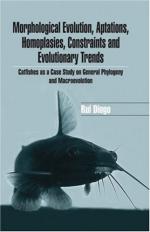|
This section contains 387 words (approx. 2 pages at 300 words per page) |
Homoplasy refers to similarity among unrelated organisms. The wings of birds, bats, and insects are homoplastic features because the common ancestor of these three groups lacked wings. Spines (modified leaves) and thorns (modified stems) are an example of homoplasy among plants; spines and thorns look similar and both provide protection to the plant, but the plants to which they belong are distantly related. Homoplastic similarity can be anatomical, physiological, or behavioral.
Homoplasy can occur by convergence, parallelism, or reversal. Convergent evolution is the independent evolution of a feature in unrelated taxa. The wings of birds, bats, and insects, which evolved independently to perform the common function of flight, are an example of convergent evolution. In parallel evolution, closely related taxa that diverged from a common ancestor evolve in a similar fashion. For example, New World and Old World porcupines have quills, but their common ancestor did not. Convergence and parallelism are often used synonymously, and convergence is the more commonly used term. Reversal refers to the loss of a derived feature with the reestablishment of an ancestral one. For example, snakes lost appendages and reverted to the ancestral state.
Similarity among organisms can arise via homoplasy or homology. Homology is similarity due to common ancestry. Bat wings, the front flipper of a whale, and the human arm are homologous because the front limb bones of the common ancestor of these mammals had a similar structure. Wings in different bird species are homologous features, as are cactus spines and pea tendrils (both are modified leaves).
Distinguishing between similarity due to homoplasy and similarity due to homology can be a difficult task for researchers. Evolutionary biologists are interested in grouping organisms by phylogeny, or their true evolutionary relationships, and homoplastic features can be misleading. Grouping organisms solely by overall similarity (also known as phenetic classification) may include homoplastic features and produce an erroneous phylogenetic tree (a graphical representation of evolutionary history). For example, bird and bat wings look the same superficially, but birds and bats are unrelated. Bat wings and the human arm look different and function differently, but these animals are related. While homoplasy can be an obstacle to determining true phylogeny, it is also an important evolutionary event; convergent evolution, for example, illustrates that unrelated organisms adapted to similar environmental constraints in a similar way.
|
This section contains 387 words (approx. 2 pages at 300 words per page) |


